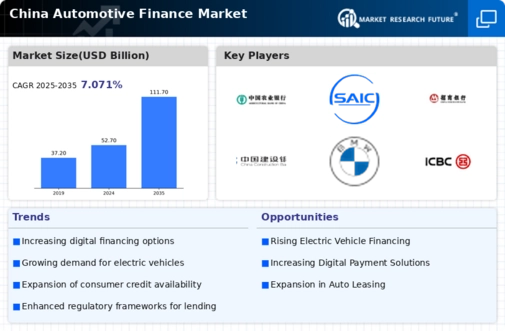Shift Towards Used Vehicle Financing
The automotive finance market in China is witnessing a shift towards financing used vehicles, driven by changing consumer preferences and economic considerations. In 2025, it is anticipated that the used car market will account for over 50% of total vehicle sales, prompting financial institutions to develop tailored financing solutions for pre-owned vehicles. This trend may be attributed to the increasing affordability of used cars, as well as the growing awareness of their value among consumers. As a result, lenders are likely to enhance their offerings, including lower interest rates and flexible repayment terms for used vehicle loans. This shift not only broadens the scope of the automotive finance market but also caters to a diverse range of consumers, from first-time buyers to budget-conscious individuals.
Increasing Consumer Demand for Vehicles
The automotive finance market in China is experiencing a notable surge in consumer demand for vehicles, driven by rising disposable incomes and urbanization. As more individuals seek personal transportation, the need for financing options becomes paramount. In 2025, the average price of a new vehicle in China is projected to be around $30,000, prompting consumers to explore financing solutions. This trend indicates a shift towards longer loan terms and lower monthly payments, which are appealing to buyers. Consequently, financial institutions are adapting their offerings to cater to this growing demand, enhancing the overall automotive finance market. Furthermore, the increasing preference for electric vehicles (EVs) is likely to influence financing structures, as consumers may seek specialized loans or incentives for eco-friendly options.
Rising Interest Rates and Economic Factors
The automotive finance market in China is currently influenced by rising interest rates, which are affecting consumer borrowing costs. As the central bank adjusts monetary policy, the cost of financing vehicles may increase, potentially impacting sales. In 2025, average interest rates for auto loans are projected to rise to around 6%, which could deter some consumers from pursuing financing options. However, this environment may also encourage lenders to innovate and offer competitive rates or flexible terms to attract buyers. Economic factors, such as inflation and employment rates, further complicate the landscape, as they influence consumer confidence and spending power. Consequently, the automotive finance market must navigate these challenges while adapting to changing economic conditions.
Expansion of Financial Technology (FinTech)
The rise of FinTech companies in China is significantly impacting the automotive finance market. These innovative firms are leveraging technology to streamline the financing process, offering consumers faster and more convenient access to loans. In 2025, it is estimated that approximately 40% of vehicle financing in China will be facilitated through digital platforms, reflecting a shift from traditional banking methods. This transformation not only enhances customer experience but also increases competition among lenders, potentially leading to more favorable terms for consumers. Additionally, the integration of big data and artificial intelligence in credit assessments allows for more accurate risk evaluations, further driving growth in the automotive finance market. As FinTech continues to evolve, it may reshape the landscape of vehicle financing, making it more accessible to a broader audience.
Government Incentives for Vehicle Purchases
Government policies in China are playing a crucial role in stimulating the automotive finance market. Various incentives, such as subsidies for electric vehicles and tax reductions, are encouraging consumers to purchase new cars. In 2025, the Chinese government aims to increase the share of EVs in total vehicle sales to 25%, which may lead to a corresponding rise in financing options tailored for these vehicles. Such initiatives not only promote sustainable transportation but also enhance the attractiveness of financing solutions. As consumers take advantage of these incentives, financial institutions are likely to develop specialized products to meet the unique needs of buyers, thereby expanding the automotive finance market. This alignment between government policy and market offerings could foster a more dynamic financing environment.



















Leave a Comment